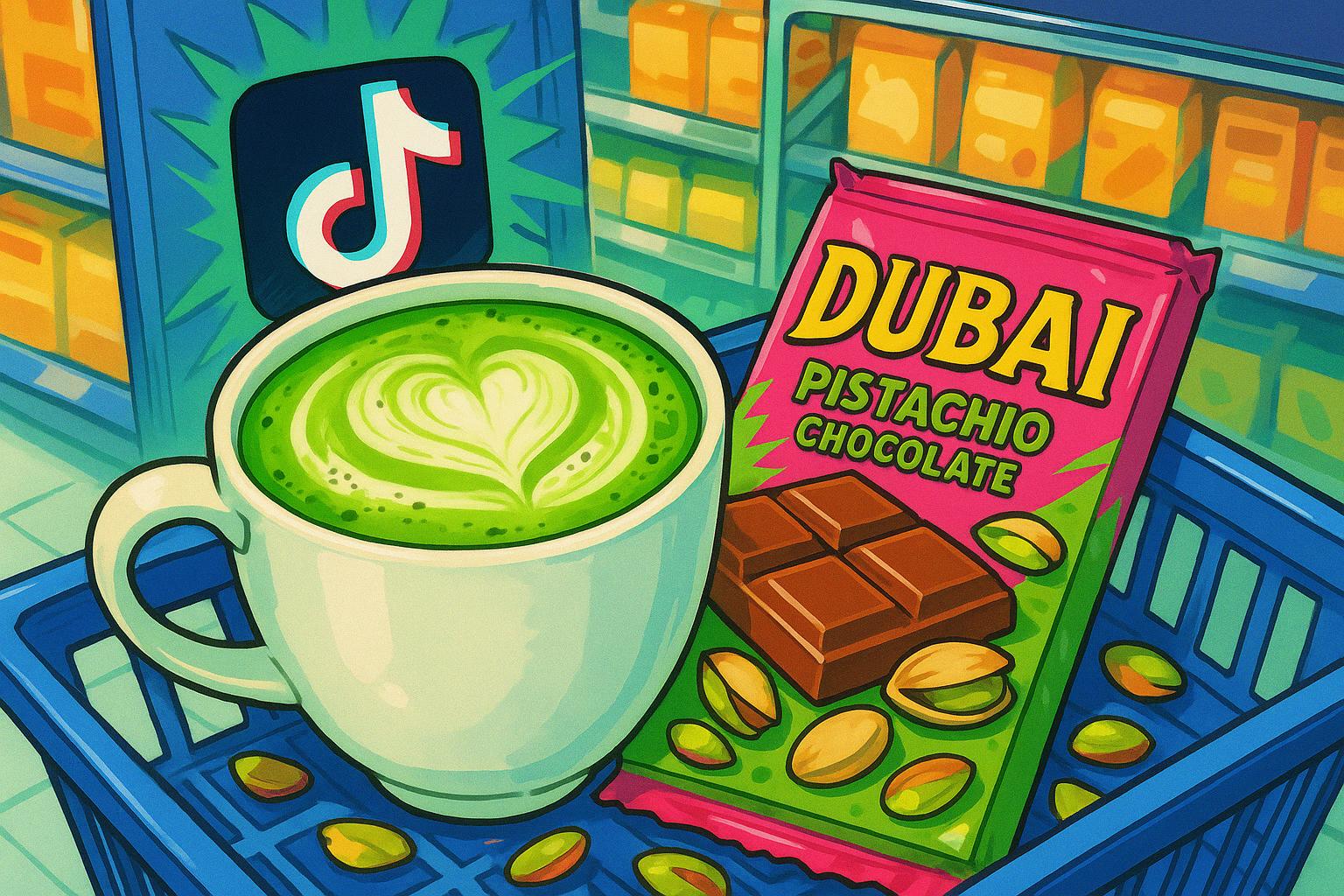Viral TikTok sensations like the ‘Dubai chocolate bar’ and matcha lattes are reshaping UK supermarket shelves, but soaring demand for scarce ingredients like pistachios is driving price hikes and raising concerns about environmental sustainability.
TikTok’s enigmatic algorithm, which has reshaped cultural dialogues across various domains, is now making waves in the culinary world, transforming how supermarkets respond to consumer preferences. While they once served as trendsetters, supermarkets are now influenced by viral social media content, as highlighted by Zoe Simons, a brand development chef at Waitrose. “The power has flipped,” she states, underscoring the shift from traditional menu analysis to real-time responses dictated by platforms like TikTok and Instagram.
This shift is dramatically illustrated by the surging popularity of matcha lattes—once a niche product, now prominently featured in major chains such as Pret a Manger and Starbucks. More notably, the so-called ‘Dubai chocolate bar’—which features a blend of pistachio cream, tahini, and knafeh—has generated remarkable enthusiasm online, becoming a viral sensation through a single TikTok video viewed over 120 million times. This explosion of interest has prompted UK retailers like Lidl and Waitrose to race to introduce their own versions of the bar, with Waitrose imposing a purchase limit to manage initial demand.
However, the consequences of this rapid consumer trend are reverberating through the agricultural sector. The unprecedented demand has led to significant shortages in the availability of key ingredients, particularly pistachios, which have seen their prices surge from €6.65 to €8.96 per pound—a near 35% increase. Forecasts suggest prices might even reach €10.80 by year-end, according to data from the monitoring platform Tridge. The U.S. remains the world leader in pistachio production, contributing about 43% of global output, predominantly from California. Yet, the current spike in demand poses challenges even amidst increased production efforts.
A similar narrative holds true for matcha, where a recent peak in demand led renowned Japanese tea houses like Ippodo to implement purchase limits. Last year, Japan manufactured approximately 4,176 tonnes of matcha—nearly triple the amount produced in 2010—yet supply remains strained due to soaring global interest. This shortage has been a significant hurdle for new businesses like Frothee, a matcha and coffee shop recently opened in London by 25-year-old Hanife Hursit and her father. Despite the high demand for trendy beverages, Hursit finds herself grappling with supply limitations and escalating wholesale prices when contemplating adding pistachio-flavoured items to her menu.
As market analyst Mzingaye Ndubiwa points out, the unsustainable nature of certain crops used in these products raises additional concerns. Pistachios, for example, are notably water-intensive and largely grown in drought-prone areas like California and Iran. This not only places strain on local water supplies but also raises questions about the long-term viability of increased cultivation spurred by social media trends. The environmental impact is further complicated by the risk of monoculture farming, which can degrade ecosystems and lead to increased reliance on herbicides and pesticides, ultimately harming soil and water systems.
The culinary world’s pivot toward trends driven by platforms like TikTok serves as a fascinating case study of how digital culture is reshaping consumer habits and market dynamics. Yet, with rapid shifts come significant challenges—resources become strained, agricultural practices are put to the test, and environmental considerations come to the fore. As these trends continue to unfold, the interplay between consumer appetite and sustainable practices will undoubtedly determine the future landscape of food retail.
 Reference Map:
Reference Map:
- Paragraph 1 – [1], [2]
- Paragraph 2 – [1], [3], [4]
- Paragraph 3 – [1], [5], [6]
- Paragraph 4 – [1], [2], [3]
- Paragraph 5 – [1], [4], [6]
Source: Noah Wire Services
- https://www.theguardian.com/business/2025/may/24/from-matcha-lattes-to-dubai-chocolate-how-supermarkets-fight-to-cope-with-tiktok-trends – Please view link – unable to able to access data
- https://www.theguardian.com/business/2025/may/24/from-matcha-lattes-to-dubai-chocolate-how-supermarkets-fight-to-cope-with-tiktok-trends – This article discusses how TikTok trends are influencing supermarket product offerings. It highlights the shift from supermarkets setting trends to responding to viral content, such as the popularity of matcha lattes and the ‘Dubai chocolate’ bar. The piece also touches on the challenges supermarkets face in adapting to these rapid changes, including supply chain issues and the need for quick product development.
- https://www.huffingtonpost.es/virales/llega-mercadona-productos-mas-deseados-vale-1-95-y-cuando-lo-saco-lidl-se-agoto-horas.html – Mercadona has launched the highly anticipated ‘Dubai chocolate’ bar from the Hacendado brand, priced at €1.95. This product, which caused a sensation when Lidl released it and sold out within hours, combines pistachio cream, crushed kataifi pastry, and milk chocolate. Its international popularity has led to a global pistachio shortage, increasing prices, as reported by the Financial Times.
- https://as.com/actualidad/sociedad/este-producto-viral-ha-provocado-una-crisis-mundial-de-pistachos-n/ – A handcrafted chocolate bar from Dubai, consisting of milk chocolate, pistachio cream, and kataifi pastry, has gone viral on TikTok with over 120 million views. This surge in demand has led to a global pistachio shortage, raising prices from $7.65 to $10.30 per pound. The shortage has impacted the food industry, especially in countries like Turkey, where baklava producers face difficulties due to the scarcity.
- https://www.ft.com/content/1844d9c9-e4a0-486d-b09c-53e780eff4e1 – The viral popularity of Dubai chocolate—a luxurious blend of pistachio cream, shredded pastry, and milk chocolate—has led to a global pistachio shortage, pushing prices from $7.65 to $10.30 per pound. Initially launched by boutique Emirati chocolatier FIX in 2021, the chocolate skyrocketed in demand after a December 2023 TikTok video garnered over 120 million views. This sudden surge in popularity has spawned numerous imitations and significantly strained pistachio supplies, already depleted by a weak U.S. harvest.
- https://cadenaser.com/nacional/2025/04/19/una-barra-de-chocolate-viral-en-tiktok-provoca-escasez-global-de-pistachos-cadena-ser/ – A chocolate bar named ‘Can’t Get Knafeh of It’, produced by the Emirati chocolatier Fix in Dubai, has caused a global pistachio shortage after going viral on TikTok in late 2023, reaching over 120 million views. The bar combines milk chocolate, pistachio cream, and kataifi pastry, leading to unexpectedly high demand. As a result, many stores have started rationing its sale, and the price of pistachios has increased significantly due to supply chain pressures.
- https://www.huffingtonpost.es/virales/ha-tardado-llegar-espana-primaprix-ya-tiene-este-codiciado-producto-por-7-95-euros.html – The famous Dubai chocolate, known for going viral on TikTok, has finally arrived in Spanish supermarkets. Primaprix sells it for €7.95 per 95-gram bar, nearly €80 per kilogram. Lidl also offers it at a more affordable price of €4.49 for a 120-gram bar, resulting in €36.80 per kilogram. This chocolate has gained popularity for its combination of milk chocolate, pistachio cream, and kataifi pastry. Users have expressed criticism over its high price and the difficulty of finding it in some Primaprix supermarkets.













